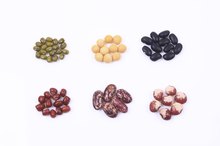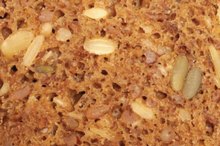What does fact checked mean?
At Healthfully, we strive to deliver objective content that is accurate and up-to-date. Our team periodically reviews articles in order to ensure content quality. The sources cited below consist of evidence from peer-reviewed journals, prominent medical organizations, academic associations, and government data.
The information contained on this site is for informational purposes only, and should not be used as a substitute for the advice of a professional health care provider. Please check with the appropriate physician regarding health questions and concerns. Although we strive to deliver accurate and up-to-date information, no guarantee to that effect is made.
Glycemic Index of Proteins
Out of the three primary macronutrients -- proteins, carbohydrates and fats -- only carbohydrates have a significant effect on a food's glycemic index, or GI 1. When you eat foods high in carbohydrates, your blood glucose level rises. The GI measures how quickly that increase takes place, and how much your glucose level changes. Though monitoring the GI of the foods you eat may help you maintain a healthy weight, stabilize your blood sugar and prevent diabetes, a high-protein diet may not meet all your nutritional needs.
Glycemic Index
The glycemic index measures the fluctuations in a healthy person's blood sugar after eating a food containing carbohydrates 1. Foods that raise blood sugar quickly have a higher ranking on a scale of 1 to 100 than foods that raise blood sugar slowly. Because foods that contain only protein, or protein and fat, have little or no immediate impact on blood glucose levels, the methods used to test GI from these foods on human subjects do not work.
Protein and Blood Sugar
Does Mixing Proteins With Carbs Reduce Insulin Response?
Learn More
Although your liver eventually converts protein into glucose, the process happens in such a way that the glucose has little or no immediate impact on your blood sugar. According to Marion J. Franz, M.S., R.D., almost none of the glucose that your liver produces from protein enters your general blood circulation. This may be because the amount of glucose produced is so small that your body uses it immediately if you have adequate insulin. Another theory suggests that the insulin triggered by protein may cause such a rapid conversion of glucose to stored energy that the glucose doesn't register when testing your blood sugar levels.
- Although your liver eventually converts protein into glucose, the process happens in such a way that the glucose has little or no immediate impact on your blood sugar.
- This may be because the amount of glucose produced is so small that your body uses it immediately if you have adequate insulin.
Balancing Proteins
The age-old pairing of meat and potatoes may make sense if you're trying to lower the overall GI of your diet. Because proteins have little or no effect on your blood sugar, eating meat with a starchy, high-GI food like potatoes may counterbalance the effects of the carbohydrates. The U.S. Department of Agriculture's pyramid for healthy eating devotes a relatively small segment to protein-based foods, emphasizing lean proteins like legumes, fish, tofu and skinless poultry.
Risks of a High-Protein Diet
Signs & Symptoms of Too Much Protein in the Diet
Learn More
Even if you're focusing your diet on foods with a low GI, a high-protein diet may not be healthy for you. High-protein diets may lead to weight loss in the short term, but restricting carbohydrates for more than three or four months may lower your fiber intake, cause constipation and increase your risk of colon cancer, says MayoClinic.com 2.
Suggestions
When you combine protein with fiber and carbohydrates in the same food or meal, you benefit from the tissue-building amino acids in the protein and the energy released by the carbohydrates. You don't have to eliminate high-GI foods or base your diet on proteins to maintain a healthy weight and stable blood sugar -- just combine these foods with plenty of fiber-rich, low-GI legumes, vegetables, fruits and whole grains.
Related Articles
References
- The Glycemic Index
- MayoClinic.com: High Protein Diets: Are They Safe?
- Diabetes Spectrum: Protein Controversies in Diabetes, Marion J. Franz, November 2000
- National Institutes of Health. MedlinePlus. Glycemic index and diabetes.
- The University of Sydney. About the Glycemic Index.
- Glycemic Index Foundation. About the Glycemic Index.
- Glycemic Index Foundation. Glycemic Load.
- American Diabetes Association. Glycemic targets: Standards of Medical Care in Diabetes-2020. Diabetes Care. 2020;43(Suppl 1):S66-S76. doi:10.2337/dc20-S006
- American Diabetes Association. Lifestyle management: Standards of medical care in diabetes-2019. Diabetes Care. 2019;42(Suppl 1):S46‐S60. doi:10.2337/dc19-S005
- Shukla A, Iliescu R, Thomas C, Aronne L. Food order has a significant impact on postprandial glucose and insulin levels. Diabetes Care. 2015; 38(7):e98-e99. doi:10.2337/dc15-0429
- The University of Sydney. Glycemic Index Research Services. Glycemic index. 2019.
Writer Bio
Anne Tourney specializes in health and nutrition topics. She is a registered nurse with experience in medical-surgical nursing, behavioral health and geriatrics. Tourney earned a Bachelor of Science in nursing from Regis University.








